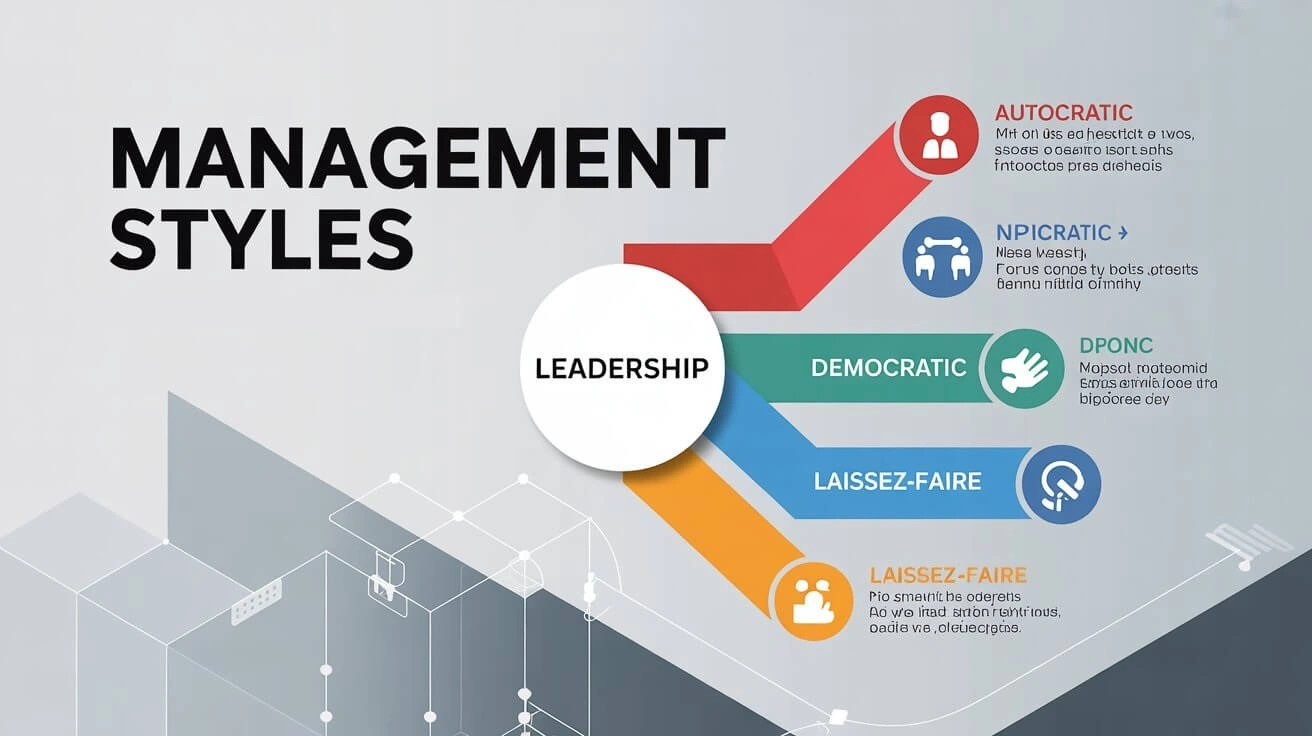Your management style shapes how your team performs, communicates, and achieves goals. By understanding different types of management styles, you can lead more effectively. This guide explores seven common styles, with pros, cons, and real-world examples to help you find the right fit.

Content
What Is a Management Styles?
A management style refers to how a manager or leader directs, guides, and motivates their team. It shapes decision-making processes, communication, conflict resolution, and team development.
While some leaders naturally favor one approach, great managers often adapt their leadership style based on team needs, company culture, and the specific challenges at hand.
Choosing the right management style can:
- Increase employee engagement and morale
- Improve productivity and efficiency
- Build trust and reduce turnover
1. Autocratic Management Style
The autocratic style (or authoritarian leadership) involves centralized decision-making with minimal input from employees. Managers give clear directions and expect them to be followed.
Best for: Time-sensitive environments, high-risk industries, or teams requiring close supervision.
Advantages:
- Streamlined decision-making
- Strong control and direction
- Useful in emergencies or high-stakes environments
Disadvantages:
- Limits team creativity
- Can lead to low morale over time
- May cause high employee turnover
Example: A manufacturing plant manager might use this style to ensure safety protocols are followed without deviation.
2. Democratic Management Style
The democratic (or participative) management style encourages input and collaboration from team members. Managers share decision-making power and value open dialogue.
Best for: Creative teams, knowledge-based roles, collaborative environments.
Advantages:
- Promotes team buy-in
- Encourages diverse viewpoints
- Builds a strong sense of ownership
Disadvantages:
- Decision-making can be slower
- May be ineffective in hierarchical cultures
- Can be hard to manage with large teams
Example: A product development team gathering input from engineers, marketers, and designers to shape the next release.
3. Laissez-Faire Management Style
Laissez-faire managers take a hands-off approach, allowing employees to make decisions and manage their work independently. Leaders offer minimal guidance and intervene only when necessary.
Best for: Highly skilled, self-motivated teams; creative industries.
Advantages:
- Boosts innovation and autonomy
- Builds trust with experienced employees
- Encourages initiative and responsibility
Disadvantages:
- Lack of oversight may lead to disorganization
- Can result in inconsistent results
- Some employees may feel unsupported
Example: A software development team with senior engineers working on independent modules may benefit from this approach.
4. Transactional Management Style
In a transactional style, leaders use a system of rewards and consequences to manage performance. It emphasizes structure, goals, and measurable outcomes.
Best for: Sales teams, call centers, and other metric-driven roles.
Advantages:
- Clear expectations and structure
- Easy to track performance
- Motivates through tangible rewards
Disadvantages:
- May stifle creativity and long-term innovation
- Can feel impersonal
- Limited focus on team development
Example: A retail store manager setting daily sales targets and offering bonuses for top performers.
5. Transformational Management Style
Transformational leaders inspire and motivate their teams to exceed expectations by focusing on a shared vision. They lead with enthusiasm, passion, and a strong sense of purpose.
Best for: Fast-growing companies, startups, mission-driven organizations.
Advantages:
- Encourages innovation
- Builds strong loyalty
- Drives continuous improvement
Disadvantages:
- Can overlook operational details
- May be exhausting for teams long-term
- Success depends on team alignment
Example: A founder leading a startup through rapid expansion, inspiring the team to embrace change and push boundaries.
Choosing the Right Management Styles
There’s no single “best” management style—the ideal choice depends on a variety of factors, including:
- Team size and skill level
- Workplace culture and values
- Nature of the task (creative vs. operational)
- Time constraints and deadlines
Many modern leaders adopt a hybrid leadership style, adjusting their approach based on team dynamics or project requirements. For instance, a manager might use a coaching approach for junior staff, a transformational approach during company change, and a transactional approach to meet monthly quotas.
Tips to Improve Your Management Styles
- Ask for feedback: Use surveys or check-ins to gauge how your style affects team morale.
- Adapt when needed: Flexibility shows emotional intelligence and earns team trust.
- Observe other leaders: Shadow colleagues or mentors to see alternative styles in action.
- Take training courses: Leadership development programs can help you evolve your style.
Conclusion
Effective leadership starts with self-awareness. By learning about different management styles—from autocratic to coaching—you gain the tools to guide your team with confidence, empathy, and purpose. The best leaders are those who can assess the moment, understand their team’s needs, and choose a management style that maximizes both performance and well-being.
FAQs
What is the most effective management style?
The most effective management style depends on your team and goals. Many leaders use a flexible or hybrid approach based on the situation.
What are the 5 main types of management styles?
The 5 main management styles include autocratic, democratic, laissez-faire, transactional, transformational, servant leadership, and coaching.

Ryan Myers is a business blog author and writer. He graduated from the University of California, Berkeley in 2009 with a degree in Political Science. His favorite topics to write about are blogging for small businesses and becoming an entrepreneur.













